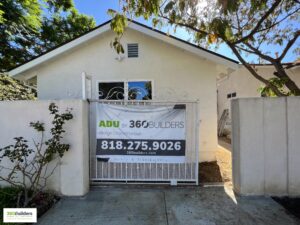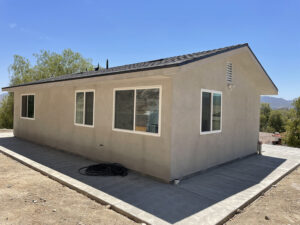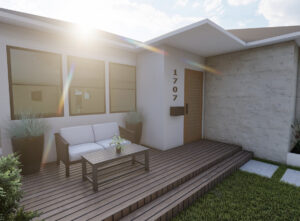If you’re thinking about buying an Accessory Dwelling Unit (ADU), also known as a secondary home on your property, in Los Angeles, CA then here’s what you need to know before making the decision. Whether they’re renting out to tenants or converting into additional living space for a family member, people around Los Angeles are curious about the benefits and drawbacks to Accessory Dwelling Units (ADUs). The city of LA, along with many other California cities, have recently relaxed their ordinances regarding these types of structures. Now that Angelenos can build ADUs inside their existing single-family homes, more people are getting educated on what it takes to get started. Planning and zoning laws vary from city to city, but here’s an overview of some common things you need to know if you’re thinking about investing in a Los Angeles ADU:
1 – Get Your Home Ready for An ADU First
Before starting the construction process, you’ll need to make sure your home is ready for an ADU conversion. Cities in LA might require that your existing home be built before 1978. They may also require the property to have a certain number of bedrooms and bathrooms. If you already live in one of these cities, check with city officials about what accessory dwelling units are permitted on the property. Otherwise, you might have to build a completely independent structure on your property in order to get around this restriction.
2 – ADUs Are a Bigger Space Than You May Think
Even though an ADU is technically only supposed to be one-quarter of the size of the primary home, it will often feel bigger than that. Think about all the additional square footage you’ll have inside, including a kitchen, living room, dining area and bathrooms. An ADU is also likely to feel larger compared to other attached units – like guest houses or garden apartments – because it’s built on-site instead of being connected via hallways or underground tunnels (in single family houses, an ADU is typically built on the ground floor of a home).
3 – Planning for Parking May Be A Challenge
Although rare, one drawback to an ADU is that it often comes with less parking than other living options. According to LA City’s Development Services Department, they city allows 1 space per unit – but this can vary depending on the city’s regulations. Whether you’re building an ADU or buying a property with one, know your parking restrictions before making a final decision.
4 – Building an Accessory Dwelling Unit Is A Complex Process
While an ADU doesn’t require as many permits as other buildings, it will still take longer than you might think. Planning, designing and building an ADU can take anywhere from 6 months to 2 years. This process might cost a bit more than you expect, too. An ADU (such as a bedroom or bathroom addition) doesn’t have to match the overall architecture of your home, but it will require hiring an architect for plan review and permits – which can cost anywhere from $1,000 to $6,000 depending on the complexity of the project.
5 – There Are Tax Benefits
The cost of a home addition might also be tax deductible. If you’re building an ADU for someone who is related to you or a special friend, it could be considered an eligible dependent care facility. If you rent it out after living in the structure yourself, that would qualify as a second home for tax purposes.
6 – You Can Make an ADU Out of Just About Anything
Thanks to their small size, accessory dwelling units can be found tucked into just about any type of building, from historic houses to condominiums. However, this also means that the design of ADU can vary tremendously. If you’re looking for a specific exterior style or room layout, it’s best to speak with your architect before visiting building supply stores and contractors.
7 – Your Accessory Dwelling Unit Can Be Used for Anything
If you own a property in LA and are thinking about creating an ADU, you might be wondering what you can do with the extra space – including renting it out. For most people, an ADU is used as a guest house or rental unit. Other uses include homes for aging parents, offices and storage units (although these are less common).
8 – You Can Rent Out an Accessory Dwelling Unit
Once you build an ADU, your property can become a money-making asset. With the average cost of rent in LA hovering around $2,000/month for a one-bedroom apartment (and nearly $3,200 on average for a two-bedroom unit), adding extra income is sure to appeal to many homeowners. If you’re planning on renting out your ADU, know that city regulations restrict it to one single-family home with no more than two units. That means you can’t combine an ADU with a studio or townhouse – even if the unit is part of the original property. In addition, if you live in Los Angeles and rent out your ADU through Airbnb, you’ll need to collect a Transient Occupancy Tax from your guests.
9 – Building an Accessory Dwelling Unit Is an Investment You Can Feel Proud Of
Just because an accessory dwelling unit offers rental potential doesn’t mean that it’s just like any other apartment building. Your home will be unique, especially since you can make stylistic changes to the unit to reflect your personal sense of style. In addition, building an ADU might be a great way to add value and increase resale value when it’s time for you to sell your home.
10 – Your Home Can Thrive with an ADU
If you’re a homeowner living in Los Angeles, you might want to purchase a property where an ADU has already been built. You can easily convert your garage into an ADU or add additional space by building onto the main living area of your home. With this extra square footage, you’ll enjoy more privacy and flexibility within your existing structure. In addition, since it will feel like another part of your home, it will be easy to keep your property in tip-top shape as you enjoy living with this accessory dwelling unit.
11 – Accessory Dwelling Units Are Allowed in Most Residential Zones
If you’re thinking about building an ADU on a smaller parcel of land, know that the zoning laws for these projects are fairly lenient. To build an ADU, you’ll need to abide by the size requirements for your specific zone – but most of them will be allowed if your lot meets minimum setbacks and floor-area ratios. One exception is if you live in a historic residential zone, where the rules will vary on a case-by-case basis.
12 – Building an ADU Is A Big Job, But It Can Be Done In Phases
If you’re thinking about building an ADU on your property in Los Angeles and you’d prefer to see how it goes before committing to the full project, try breaking it up into smaller phases. For example, build the ADU as a separate structure, then decide whether you want to rent it out or combine it with your main home. Another option is to build an ADU where you currently park your car. This way, when you’re ready to expand, you won’t have to start from scratch – just add a second floor onto the space that’s already there.
There are many things to consider before making the decision whether to invest in an ADU or not. Hopefully, this article was helpful in spelling out a few of the most important things to consider when you are making this decision.







